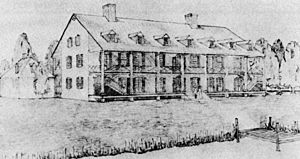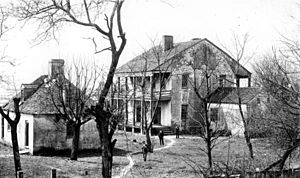William Panton facts for kids
William Panton (born around 1740 – died 1801) was a Scottish merchant. In 1783, he led a group of five Scottish businessmen to start a very important trading company called Panton, Leslie & Company. This company was based in St. Augustine, Florida, which was then the capital of British East Florida. They worked together to trade with the Native American tribes in Florida and the nearby Spanish lands. By 1795, their company had become the main trading partner for Native American tribes in what is now the southeastern United States. The Spanish governors of Spanish Florida even approved their special trading rights.
Contents
Early Life and Business in America
William Panton was born in Scotland, on a family farm called Mains of Aberdour. In 1765, he moved to Charleston, South Carolina, with his friend Thomas Forbes. Panton learned about trading with Native Americans by working as an apprentice for a company owned by John Gordon. Gordon was another Scottish immigrant who had a huge trading network across South Carolina, Georgia, and Florida. Panton worked for Gordon from 1765 to 1772.
In 1776, Panton started his own trading business with Thomas Forbes in Savannah, called Panton, Forbes and Company. They traded with the growing number of white settlers and bought large areas of land in Carolina and Georgia. When the American Revolution began, Panton and Forbes were loyal to Britain. Because of this, their properties were taken away. They then moved to East Florida, which was a British area at the time. They set up their business again on the St. Marys River.
In 1775, the British governor of East Florida, Patrick Tonyn, made Panton the official trader for the Creek Native Americans. Later, in 1778, a British agent named Colonel Thomas Brown put Panton in charge of giving gifts to the Creek and Cherokee tribes. Giving gifts was a key part of how the British kept good relationships with these tribes. Panton's company also focused on trading animal furs, especially deerskins. This was a very important business for the Native American tribes in the area. In 1783, Panton received an official license to continue trading with the Native Americans and provide them with British goods.
Trading in Spanish Florida
In 1783, Florida became a Spanish territory again. However, William Panton was allowed to stay in the area thanks to an agreement between British officers and Manuel de Zéspedes, the Spanish governor. Panton had managed to impress Governor Zéspedes, who spoke up for him to the Spanish king. In 1786, the Spanish king officially allowed Panton, Leslie & Company to keep trading with the Native Americans in Florida.
The company did a lot of business in St. Augustine, managed by John Leslie. The Spanish often hired them to provide goods and lend money. Some of the company's partners were even allowed to buy and own land in East Florida. John Leslie stated that the main partners of the company were William Panton, Thomas Forbes, Charles Maclatchy, and himself. He also said the company owned 72,820 acres of land in the province.
Later in 1783, Panton and William Alexander moved to Nassau in the Bahamas. This city then became the main hub for the company's operations, where they stored their trade goods in large warehouses.
In 1785, Panton and John Forbes arrived in Spanish Pensacola with a shipment of goods from Nassau. They set up the new company headquarters there because the amount of trade was growing faster than at their St. Augustine branch. By 1786, Panton, Leslie and Company owned nineteen separate land grants. They also had 250 people who were forced to work on their plantations and ranches. In 1789, Panton's company also gained control of the trade with the Choctaw and Chickasaw tribes in Mobile.
By 1795, Panton, Leslie & Company had a monopoly on trade with Native American tribes in the southeastern United States. Their business reached from Pensacola north to Fort San Fernando (near what is now Memphis) and west to New Orleans. They had trading posts in Mobile, several places in Florida, the Bahamas, and around the Caribbean.
A Major Trading Company
Panton, Leslie & Company earned a lot of money from trading with Native Americans. In the 1790s, it became the largest trading company in the southern frontier. They worked closely with Alexander McGillivray, an important chief of the Upper Creek (Muscogee) towns. McGillivray was a close friend of Panton and is thought to have been a secret partner in the company. Panton had promised him a share of the company's profits once the Spanish approved their business. McGillivray was often sick and passed away in 1793. He was buried in Panton's garden in Pensacola.
The company set prices to be lower than their competitors in Georgia and South Carolina. They also sent agents throughout the Native American lands and helped carry messages from the Spanish government to the tribes. While Panton, Leslie & Company was a legal trading firm, they also moved goods across borders without permission and managed the market to their benefit. These practices were probably common for trading companies in those frontier areas. After William Panton and John Leslie died, the company was reorganized in 1804 and became John Forbes & Company.
Death
In January 1801, William Panton became very ill in Pensacola. His doctor advised him to travel to a different climate immediately. So, he sailed for Havana, Cuba, with his doctor on the company's ship, the Shark. They left quickly, even though his official recommendation letters had not arrived yet. Unfortunately, the Cuban authorities would not let him leave the ship without these papers because of the ongoing war between Spain and Great Britain. He then continued his journey toward Nassau, but he died at sea on February 26, 1801. He was buried at Great Harbour Cay in the Bahamas.



